
by Thierry Meyssan
After liberating Western Europe in
1945, the United Kingdom and the United States decide to recast it, by creating
the United States of Europe. Flooding millions of dollars, the CIA and JIC
finance pro-European associations to mould them into instruments to contain
communism. Allen Dulles and Joseph Retinger manage to establish a European
Council and the ECSC, but they fail to establish a European Defense Community.
VOLTAIRE NETWORK | PARIS
(FRANCE) | 28 JUNE 2004 
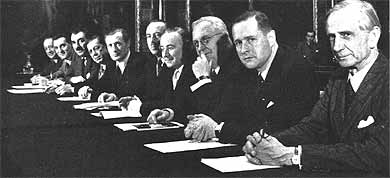
A meeting
of the Executive Committee of the European Movement (1949). From right to left:
the fifth person is Paul Van Zeeland, then the Chair, Duncan Sandys and the
Secretary General Joseph Retinger
It is in 1922 that Count Richard de
Coudenhove-Kalergi publishes his celebrated work: Pan Europa, un projet [1]. The Austro-Hungarian aristocrat, recycling the
analysis of a senior French official, Louis Loucheur [2], states that modern wars require gigantic industrial
capacities. Conversely, conflicts between the big powers may be avoided if they
pool their resources under a common authority. One can hope to prevent another
war between Germany and France by placing German coal and French steel under
the control of a bi-national authority. Extending this reasoning, but this time
weaving in the thinking of Giovanni Agnelli [3] on European federalism as an antidote to retributive
nationalism, Coudenhove-Kalergi proposes something more radical: creating a
United States of Europe based on the US model. In this spirit, he also proposed
to establish a powerful Europe, able to offset the new blocs: the USA, the URSS
and the British Empire. So his Europe will stretch from France to Poland.
In 1926, Coudenhove-Kalergi
establishes an association, the Pan-European Union. It holds a Congress at
Vienna with more than 2,000 delegates. Its plan is peaceful cooperation between
Sovereign States. It opposes the fascist vision of a Europe integrated by force
where ethnic regions would be exalted and the nation state destroyed. It is
supported by a host of intellectuals such as Guillaume Apollinaire, Albert
Einstein, Sigmund Freud, Thomas Mann, José Ortega and Gasset, Pablo Picasso,
Rainer Maria Rilke, Saint John Perse, etc.
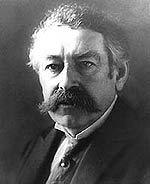
Aristide
Briand
It is the Nobel Prize Winner,
Aristide Briand [4], that is elected president of the Union.
In the thirties, Aristide Briand and
Edouard Herriot carry out the plan at the political level. Twenty six states
are contacted to form part of a Federal European Union.
Moreover, the businessman Jean
Monnet, Deputy Secretary General of League of Nations when it was first
established, notes that this is becoming a de facto inter-governmental European
organization and proposes to make it the framework for a European Union.
Unfortunately, these initiatives
arrive too late: they cannot withstand the Wall Street Crash and escalating
dangers.
The British-US plan for Western
Europe
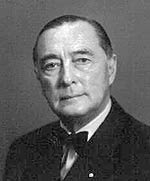
Count
Richard de Coudenhove-Kalergi
Exiled to the United States at the
end of the Second World War, Richard de Coudenhove-Kalergi undertakes extensive
lobbying to convince Washington to establish a federal organization in Europe,
once peace returned. His efforts were crowned with success when the Council on
Foreign Relations (CFR) adopted his idea in 1946 [5] [6]. The CFR takes one of his recommendations to the
Department of State.
As for the former British Prime
Minister, Winston Churchill, in 1946 he denounces,
“the iron curtain that has come down on Europe” [7]. It is necessary to stabilize the Western Block and prevent communism from catching on.
“the iron curtain that has come down on Europe” [7]. It is necessary to stabilize the Western Block and prevent communism from catching on.
On 8 May 1946, which marks the first
anniversary of Reich’s surrender, the Royal Institute of International Affairs
(RIIA or “Chatham House”), a British organization, sister to the CFR, presents
the common position of London and Washington. It is set out by Joseph H.
Retinger, former adviser to the Polish fascist government, who is in exile in
London [8]. He became an agent of Her Majesty’s Secret
Services. This position is democratized by Winston Churchill, when he coins the
phrase “the United States of Europe” [9].
However this plan bears no relation
to Coudenhove-Kalergi’s and the inter-war democrats. London and Washington
envisage creating a common English-US citizenship to seal a great Anglophone
empire. In this context, “Europe” would be a constellation of States invited to
work together and to shift some of their industrial resources to the
jurisdiction of a supranational authority, broadly identifiably structured
along the lines of the Anglophone Empire. The ensemble would form a vast area
for free trade, impermeable to the influence of communism.
Chaos: the beginnings of US-English
Action in Western Europe
The process continues. The British
services establish an Independent League for European Cooperation (ILEC).
Joseph H. Retinger is the Secretary General and the former Belgian Prime
Minister, Paul van Zeeland, the President. Its head office is Brussels.
Branches are set up in Germany, France [10], Italy, the Netherlands, Luxembourg, and of course,
the United Kingdom. At the initiative of the US Ambassador, Averell Harriman,
another branch is set up in the US by Russell C. Leffingwell. He is president
of the CFR. The role assigned to ILEC? To promote a European area of free trade
with a single currency.
A few weeks later, in September 1946,
Allen W. Dulles, the new president of the CFR, finances the establishment of
the European Union of Federalists (EUF), at Hertenstein (Switzerland) [11] around personalist philosophers [12], notably Alexandre Marc and Denis de Rougemont, and
Henry Frenay, the former head of the resistance network, Combat [13]. The role assigned to Union of Federalists will be
to mobilize public opinion to accelerate integration (that is the surrender of
State sovereignty) something no political leader in office can promote.
In January 1947, Churchill
establishes the Provisional United Europe Committee. In March, at the
initiative of Senator J. William Fulbright, the Senate and the House of
Representatives vote a motion to support the “United States of Europe”.
Congress asks the state beneficiaries of the Marshall Plan to undertake to
participate in this “United States”.
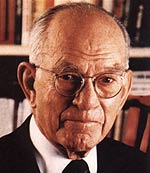
Senator J.
William Fulbright
And, in order to promote among the US
elites the ideas of Count Coudenhove-Kalergi, Senator Fulbright establishes the
Committee for a Free and United Europe with William J. Donovan and Allen W.
Dulles [14]. This marks the beginning of misunderstanding:
everyone is talking about the “United States of Europe” but they do not have in
mind the same thing.
In July 1947, the Council on Foreign
Relations Journal publishes an anonymous article, that in fact is authored by
ambassador George F. Kennan. In it he describes the danger of the spread of
communism and spells out the containment policy. The National Security Council
outlines the strategy:
• “Phase I” aims at forming a federation of all the Western European states freed by the United Kingdom and the US;
• “Phase II” will consist in extracting the states of Central and Eastern Europe in the Soviet sphere and adding them to the “United States of Europe” [15]
On 17 March 1948, the United Kingdom
signs a military cooperation treaty with France and the Benelux at Brussels.
This treaty establishes the Union of Western Europe (UWE).
Churchill calls a para-governmental
conference at the Hague to combine the Pan-European Union, ILEC, the Union of
Federalists and many others. From 7 to 10 May, 800 personalities reply to his
call and establish the European Movement. Duncan Sandys, Churchill’s
son-in-law, is elected the Association’s president and Joseph H. Retinger, the
Secretary General [16].
However, the success of this
operation depends on retaining its ambiguities. The participants have been
appealed to on various arguments, that are not always compatible. Thus it must
not be left to Coudenhove-Kalergi and his Pan European Union to clarify
matters. The European Movement leaders (i.e. the British) hurry to Washington
to work with their US opposite numbers who have not entirely understood the
subtleties of the old continent. A decision is taken to immediately close the
Committee of Senator Fulbright and to side-line Coudenhove-Kalergi. A new
structure is created to supervise European construction: the American Committee
on United Europe (ACUE).
On the other hand, in light of “Phase
II”, William Hayter, chairman of the Joint Committee on British intelligence,
puts in place a network of agents that remained in place behind the Iron
Curtain. These stay-behinds form the Assembly of Captive European Nations
(ACEN).
Finally Saint-Siège invests in the
anti-communist crusade. Pie XII hosts the Second Congress of the Union of
European Federalists at Rome, in September 1948 [17].
The American Committee for a United
Europe
ACUE is established on 5 January 1949
at the headquarters of the Woodrow Wilson Foundation at New York. Without much
secrecy, its board of directors is a directory of the US Secret Service (US
SS):
• President William J. Donovan (the former head of the US SS, who became an adviser to the CIA) ;
• Vice-president Allen W. Dulles (ex-US SS, Chair of the CFR and future director of the CIA);
• Executive director Thomas W. Braden (ex-US SS, future assistant director of the CIA); and also
• David Dubinsky, Arthur Golberg and Jay Lovestone, all three responsible for covert operations of AFL-CIO [18].
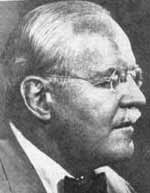
Allen W.
Dulles
The Committee has its first public
meeting on 29 March 1949, in the presence of Winston Churchill. It is a
non-governmental window of the CIA that on a purely formal basis undertakes
public activity. Its real purpose is to secretly finance all the European
federal associations. In his inaugural speech, and welcoming the spokesmen of
ACEN, Churchill declares: “It is not possible to have sustainable peace while
10 Eastern European capitals are in the hands of Communists government of the
Soviets. We have relations with these nations beyond the Iron Curtain. They
have sent their delegates to our meeting and we know their feelings and how
much they wish to be part of a new United Europe. Therefore our goal and ideal
must fall no shorter than uniting Europe, the whole of Europe.”
On 4 April 1949, the United States,
the United Kingdom, Canada and France signed the North Atlantic Alliance
(NATO).
ACUE finances the preparatory meetings
for the Treaty of Westminster (5 May 1949) establishing an organization aimed
at defining and expanding the norms of government of the “free world”, the
Council of Europe. The Belgian Prime Minister, Paul-Henri Spaak, was elected
its president.
In August 1949, the Soviet Union
exploded its first nuclear bomb. This, to the amazement of Washington. Truman
is convinced that the URSS intends to use force to expand communism. General
George F. Kennan is replaced by his second in command, Paul H. Nitze. Hereafter
the world is split between the two nuclear powers. That puts into perspective
the “special relationship” with London and consequently destines the United
Kingdom to fall from its pedestal and to form part of Europe… A shock for
London.
ACUE decides to re-seize direct
control of the European Movement, that is, by firing the British management. A
crisis is skilfully organized: the French of the Union of Federalists protest
about their non-representation in management and slam the door. On this pretext,
ACUE stops financing the European Movement. The President Duncan Sandys is
forced to resign in March 1950. He is replaced by the Belgian Spaak, who
relocates the headquarters from London to Brussels. Another Belgian, Baron
Boël [19], becomes treasurer.
The Success of the ECSC and the
failure of the CED
On 8 May 1950, on the fifth
anniversary of the capitulation of the Reich, the French Minister of Foreign
Affairs, Robert Schuman, proposes to implement the plan of Louis Loucheur and
Richard de Coudenhove-Kalergi and establish a European Coal and Steel Community
(ECSC). Schuman is a supernumerary member of Opus Dei. The secret catholic
brotherhood rebranded him by erasing the memory of his participation in the
cabinet of Philippe Pétain who signed the armistice of dishonour. In New York,
Allen W. Dulles organises a press conference during which he makes public a
list of 118 eminent US personalities, members of ACUE, who support the Schumann
Plan.
Among this crowd, on 24 October 1950,
the French Minister of Defence, René Pleven, proposes to establish a European
Defence Committee (EDC). This announcement is supported by a Supervisory
Committee, an emanation of Henri Frenay’s Union of Federalists, clearly
financed by ACUE. Six States sign the EDC Treaty at Paris, on 27 May 1952. In
contrast to Benelux, the Council of Europe and the ECSC, the EDC is not an old
project of the Europeans but a structure supported by Washington. The opposite
of the ideas of Aristide Briand envisaging a syndication of Defense modelled on
alliances between Ancient Greek cities, the Pentagon visualizes a grouping of
reserves along the lines of the Persian Empire. The Gaullists and the
Communists are united to prevent the ratification of the Treaty for a National
Assembly, that rejects it on 30 August 1954.
The beautiful structure collapses. It
is necessary to change strategy and turn to Nato. London and Washington
entrusts to Joseph H. Retinger, still Secretary General of the European
Movement, the task of recruiting high-level European personalities to jointly
further the integration of European States in a free trade zone starting with the
ECSC, and their integration into NATO. The preparatory meeting for the
establishment of this club took place on 25 September 1952 at Paris. Prince
Bernhard of the Netherlands, Paul van Zeeland, Alcide Gasperi, Guy Mollet,
Antoine Pinay [20] and some others participate. Then Retinger and
Prince Bernhard go to Washington to seek the blessing of General Walter Bedell Smith,
the new director of the CIA [21], and Charles D. Jackson, the special adviser to the
President. A US committee is formed with David Rockfeller, Dean Rusk, Henry
Heinz II, Joseph Johnson, and others. The first meeting will take place from 29
- 31 May at the Bilderberg Hotel in the Netherlands.
Translation
Anoosha Boralessa
Anoosha Boralessa
[1] In November 1922, Paneuropa, ein Vorschlag was
published at the same time in the Neue Freie Presse , Vienna and Vossische
Zeitung, Berlin.
[2] Louis Loucheur, an entrepreneur in buildings and
public works (1872-1931), introduced reinforced cement in France. A
polytechnician, close to Clemenceau, he became the Secretary of State for Arms
during the First World War. Then he was appointed Minister for Industrial
Reconstruction in the Armistice. He completely reorganized French industry
during these years of war and peace. Following this, he became Minister of Labour
and was the first to build social housing.
[3] Giovanni Agnelli (1866-1945), the founder of the
Turinese dynasty, studied the Henry Ford’s model in the United States and
established Fiat in Italy. In 1918, he published La Fédération européenne ou la
Ligue des nations. An opponent to the Treaty of Versailles and League of
Nations, his proposal is a continental European Federation where most power is
centralized. Just as Henry Ford admired Hitler, Giovanni Agnelli supported
Benito Mussolini.
[4] The radical French Minister, Aristide Briand
(1862-1932), is given a place in History for negotiating in 1905 the agreement
separating the Church and the State and because he was opposed to the policy of
retribution against Germany, in the 1920s and injected life into the League of
Nations.
[5] Let us recall that for US historiography, the Second
World War did not finish with the surrender of the Reich, on 8 May 1945, but
with a presidential declaration of the cessation of hostilities, on 31 December
1946.
[6] “Comment le Conseil des relations étrangères
détermine la diplomatie US”,Réseau Voltaire, 25 June 2004.
[7] Speech of Fulton (Missouri), 5 March 1946.
[8] After Poland had been invaded by the Reich, the
fascist government of Sikorsky positioned itself on the side of the Allies.
[9] “Winston Churchill speaking in Zurich on the
United States of Europe”,
by Winston Churchill, Voltaire Network, 19 September 1946.
[10] The French branch takes the name the European League
of Economic Cooperation (ELEC). It is chaired by Edmond Giscard d’Estaing, a
member of Opus Dei and more importantly, father of the future president of the
Republic and founder of the Ecu.
[11] During the Second World War, Allen W. Dulles had
directed the US SS (US Secret Services) in Europe since Berne.
[12] Personalism is a doctrine articulated by Emmanuel
Mounier, who was seeking to reconcile Christian respect for the human person
and collective mobilization valued both by fascism and communism. This movement
is developed around the revues L’Ordre nouveau and Esprit.
[13] From 1943, Allen W. Dulles had financed the Combat
network to sabotage the efforts of Jean Moulin who had excluded the pro-Francos
and included communists in the National Council of the Resistance.
[14] During the war, General Donovan had been the head of
the US SS and Dulles, his second in command for Europe.
[15] In reaction, URSS adopts the Zhdanov doctrine and
establishes Kominform. The United States had broken the alliance concluded
against the Nazis and supported henceforth both extreme right parties, right
wing parties or non-communist left parties to contain the natural expansion of
communism. Communists all over the world, must draw conclusions from this and
break their partnerships with the Left. They cannot rely on the help of URSS,
which becomes their de facto leader.
[16] The following were appointed Honorary Chairs:
Winston Churchill, Konrad Adenauer, Léon Blum, Alcide de Gasperi and Paul-Henri
Spaak.
[17] 26 delegates have been elected. For France these
were: the former member of the Resistance, Henri Frenay, the former Head of
Studies of École d’Uriage André Voisin, Germaine Peyroles, the philosopher
Alexandre Marc.
[18] See the enquiry of Paul Labarique “AFL-CIO ou
AFL-CIA ?” and “1962-1979: The AFL-CIO and Trade Union
Counterinsurgency”, Voltaire
Network, 2 and 11 June 2004.
[19] Moreover, Baron Boël was the president of the
Belgian section of the Independent League for European Cooperation.
[20] “Les gentlemen du Cercle Pinay”, Réseau
Voltaire, 11 March 2004.
[21] The stay-behind network has just been formally
integrated to CIA.
The articles on Voltaire Network may
be freely reproduced provided the source is cited, their integrity is respected
and they are not used for commercial purposes (license CC BY-NC-ND).
Source : “The European Union’s Secret
History”, by Thierry Meyssan, Translation Anoosha Boralessa, Voltaire
Network, 28 June 2004,www.voltairenet.org/article192787.html






No comments:
Post a Comment